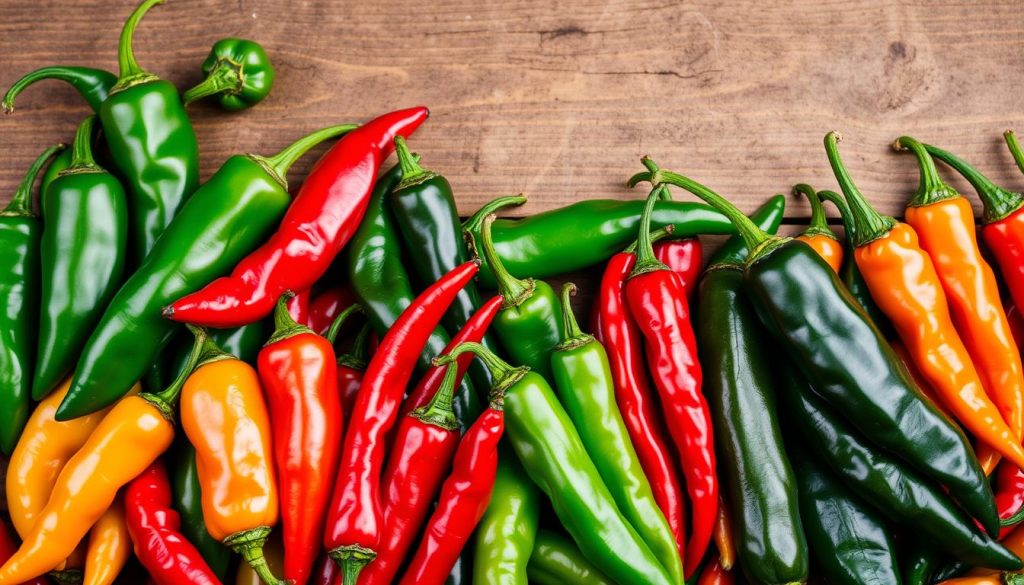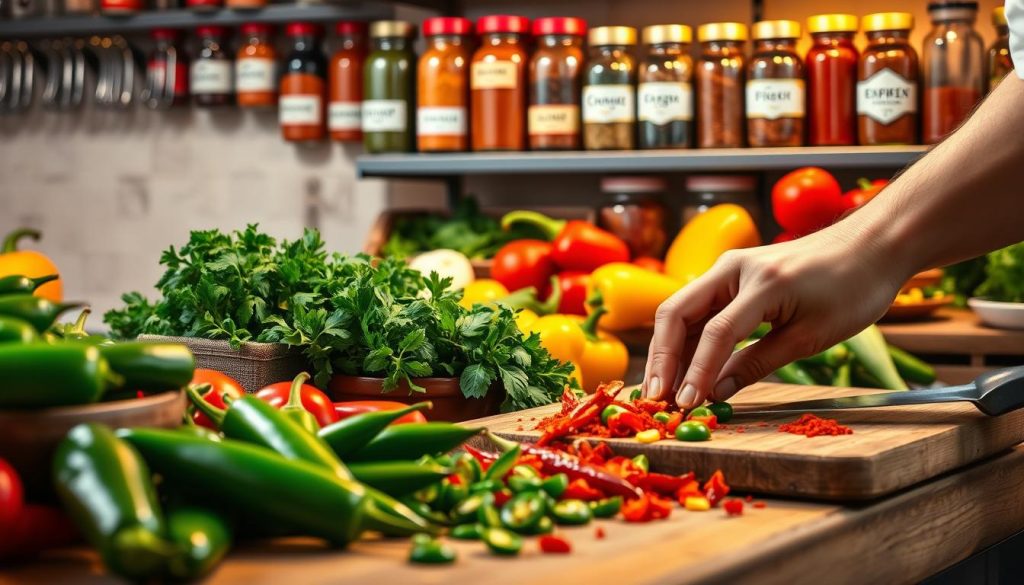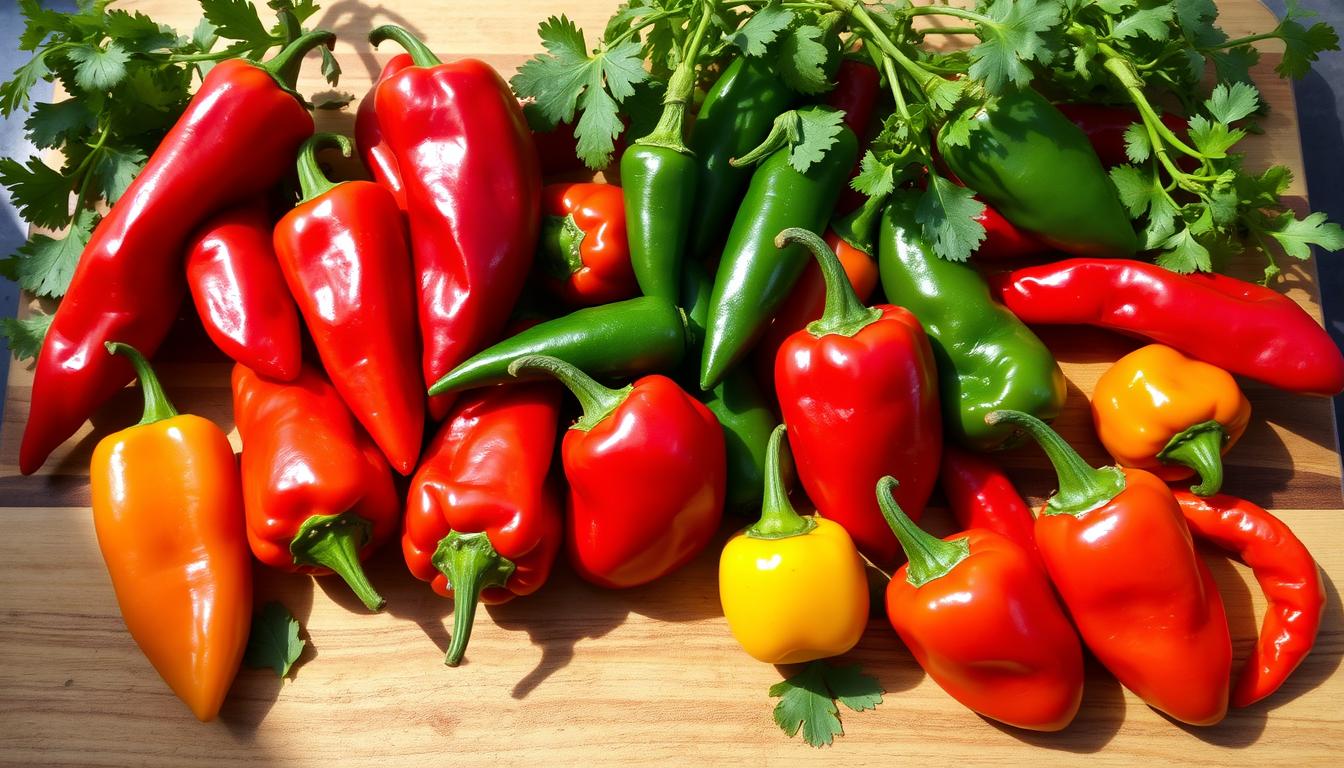Are you looking for the perfect habanero substitute? You’re not alone. Habanero peppers are known for their intense heat and fruity flavor. They’re a favorite in spicy dishes.
With a Scoville heat range of 100,000 to 325,000 SHU, they can really spice up your recipes. But, their heat might be too much for some. That’s why we’ve created this guide.
In this guide, you’ll find pepper alternatives that match habaneros in heat and flavor. You’ll learn about sweet Scotch bonnets and milder jalapeños. These options will let you enjoy bold flavors without feeling overwhelmed.
Whether you want something as fiery as habaneros or something milder, we’ve got you covered!
Understanding Habanero Peppers
Habanero peppers are known for their intense heat and unique taste. This section will dive into what makes habaneros special. We’ll look at their Scoville scale ranking and how they’re used in cooking.
Characteristics of Habanero Peppers
Habaneros grow to 1 to 2½ inches long. They come in colors like green, yellow, orange, and red. Being part of the Capsicum chinense species, they have a fruity and floral taste.
The orange habanero is the most famous type. It’s loved by chili fans for its distinct flavor.
Scoville Heat Units of Habaneros
Habaneros have a Scoville Heat Unit (SHU) rating of 100,000 to 350,000. This makes them very spicy, about 76 times hotter than a jalapeño. At their hottest, they can be up to 140 times hotter.
The Red Savina Habanero was once the world’s hottest pepper, with 577,000 SHU. Other types, like Chocolate Habanero and Caribbean Red Habanero, also pack a lot of heat. This adds excitement to spicy dishes.
Flavors and Culinary Uses
Habaneros have a bright, citrusy, and floral taste. They’re great in salsas, hot sauces, and marinades. Their intense heat pairs well with tropical fruits like pineapple and mango.
When using habaneros, remember a little goes a long way. Their heat level can make a big difference in your dishes.
https://www.youtube.com/watch?v=kJ_oejTtEjY
| Habanero Variety | Heat Level (SHU) | Flavor Notes |
|---|---|---|
| Orange Habanero | 100,000 – 350,000 | Citrusy, Fruity |
| Red Savina Habanero | Up to 577,000 | Fruity, Floral |
| Chocolate Habanero | Up to 450,000 | Earthy, Rich |
| White Habanero | Around 200,000 | Fruity, Mildly Sweet |
| Peach Habanero | 150,000 – 350,000 | Peachy, Sweet |
Top Substitutes for Habanero Peppers
Looking for the best habanero substitutes means finding peppers that match their heat and taste. Scotch bonnet, jalapeño, and serrano peppers are great options. They can add the spice you want to your food.
Scotch Bonnet Peppers
Scotch bonnet peppers are the closest to habaneros. They have a similar heat, ranging from 100,000 to 325,000 SHU. Their fruity taste makes them perfect for adding heat to recipes.
Jalapeño Peppers
Jalapeños are milder, with heat from 2,500 to 8,000 SHU. They’re easy to find in stores. Red jalapeños have a sweeter taste than green ones. Remember, jalapeños are less spicy than habaneros, so you might need more of them.
Serrano Peppers
Serrano peppers offer a fresh, grassy flavor. They’re hotter than jalapeños but milder than habaneros, with heat from 10,000 to 25,000 SHU. They’re great for adding a bit of spice without too much heat.
| Type of Pepper | Heat Level (SHU) | Flavor Profile | Recommended Use |
|---|---|---|---|
| Habanero | 100,000 – 350,000 | Fruity and spicy | Authentic spicy dishes |
| Scotch Bonnet | 100,000 – 325,000 | Fruity | Cuisine that needs robust heat |
| Jalapeño | 2,500 – 8,000 | Sweet and mild | Accessible everyday recipes |
| Serrano | 10,000 – 25,000 | Fresh and grassy | Moderately spicy dishes |
Substitute for Habanero Pepper Guide
Looking for habanero alternatives means finding flavors that are satisfying but not too hot. Mild substitutes can make your meals enjoyable, even for those who don’t like spicy food. Rocotillo peppers and other common options are great finds in grocery stores.
Mild Alternatives: Rocotillo Peppers
Rocotillo peppers have a fruity taste with less heat. They are slightly spicier than mild poblano peppers but still gentle. Their tropical flavor can add depth to your dishes without being too spicy.
Commonly Available Options
For easy substitutes, try Anaheim or banana peppers. They don’t taste exactly like habaneros but offer enjoyable flavors and a gentle heat. Jalapeño, serrano, or chipotle peppers are also good for balancing flavors and adjusting the heat to your taste.

How to Use Substitutes Effectively
When you use substitutes for habanero peppers, it’s key to know how to adjust heat and mix flavors. These tips will help you get the taste and spiciness you want in your dishes.
Adjusting Quantity for Heat
It’s important to think about the heat level of substitutes. Jalapeños and serranos are milder, with heat from 2,500 to 23,000 Scoville Heat Units (SHU). To get the intense heat of habaneros, which range from 100,000 to 350,000 SHU, you might need more of these milder peppers. Doubling the amount can help you get a similar spicy effect.
Remember, changing the amount affects not just the heat but also the flavor of your dish.
Combining Substitutes for Flavor
Trying different pepper mixes can make your meals taste better. For example, mixing serrano peppers with a bit of cayenne adds more heat and balances out the fruity taste. By experimenting with different amounts and types of peppers, you can find the perfect mix of flavors and heat.
Being creative with pepper substitutes can lead to exciting new flavors in your cooking.

Cooking Techniques for Habanero Alternatives
Using habanero alternatives can make your cooking better. Roasting and grilling bring out great flavors. Infusing oils or vinegars adds new tastes to your recipes. These methods help you get the most out of different peppers, making your dishes richer and more exciting.
Roasting and Grilling Techniques
Roasting peppers softens their taste and adds a smoky flavor. Preheat your oven to 400°F. Put the peppers on a baking sheet and roast until the skin is charred. This method makes peppers more versatile and flavorful.
Grilling peppers also adds a smoky taste. Just place them on the grill until they have nice marks. This brings out a delicious smoky flavor.
Infusing Flavors with Oils and Vinegars
Infusing oils or vinegars with peppers adds a subtle heat and rich taste. Start by mixing your favorite peppers with good oil or vinegar. This is great for dressings, marinades, and more, adding a gentle kick.
Try different pepper and oil or vinegar combinations. You’ll find amazing flavors that go well with your favorite foods.
| Cooking Technique | Method | Benefits |
|---|---|---|
| Roasting | Oven at 400°F until charred | Enhances flavor, softens heat |
| Grilling | Directly on grill until marked | Adds smokiness, versatile option |
| Infusion | Blending peppers with oils/vinegars | Subtle heat, enhances dishes |
Conclusion
In this habanero guide, you’ve explored the fascinating world of habanero peppers and their substitutes. You now know how to pick the right pepper for your dish. Whether you choose milder peppers like bell peppers or bolder ones like ghost peppers, it makes a big difference.
Using chili substitutes is more than just adding heat. It’s about adding different flavors to your meals. By using the cooking tips we discussed, you can make recipes your own. You can try the sweet taste of a Scotch bonnet or the crunchy texture of a banana pepper.
By trying out different peppers, you can make your cooking fit any occasion. With what you’ve learned, you’re ready to use chili substitutes and make your favorite dishes even better.
Source Links
- https://pepperscale.com/habanero-pepper-substitute/
- https://brokebankvegan.com/habanero-peppers/
- https://pepperscale.com/habanero-pepper/
- https://spicesinc.com/blogs/what-are-habanero-peppers?srsltid=AfmBOoq3ASRJmizzRb5BzDyzKcDxyvMF1LxwFLqCOoC0e_jG2_vUHV02
- https://www.holisticwow.com/peppers/habanero/
- https://www.cozymeal.com/magazine/jalapeno-substitute
- https://www.tastythais.com/hot-chili-peppers-substitutions/
- https://cookscrafter.com/habanero-pepper-substitutes/
- https://www.holisticwow.com/peppers/habanero/substitutes/
- https://discover.texasrealfood.com/swap-and-savor/ghost-peppers-substitutes
- https://blog.mountainroseherbs.com/the-complete-guide-to-our-organic-chili-pepper-powders
- https://spicesinc.com/blogs/guide-mexican-dried-chiles?srsltid=AfmBOopyA41zpdrmYIgvjTR4POOmAy57sun58dJaL7x5W14WHbD13iV1
- https://gustomeadow.com/habanero-pepper-substitutes/
- https://www.seriouseats.com/serious-heat-chile-substitutions
- https://www.cleaneatingkitchen.com/best-substitutes-for-chili-peppers/
- https://kitchendoings.com/9-best-habanero-pepper-substitutes/
- https://www.tastythais.com/cooking-with-chili-peppers-and-using-substitutes/
